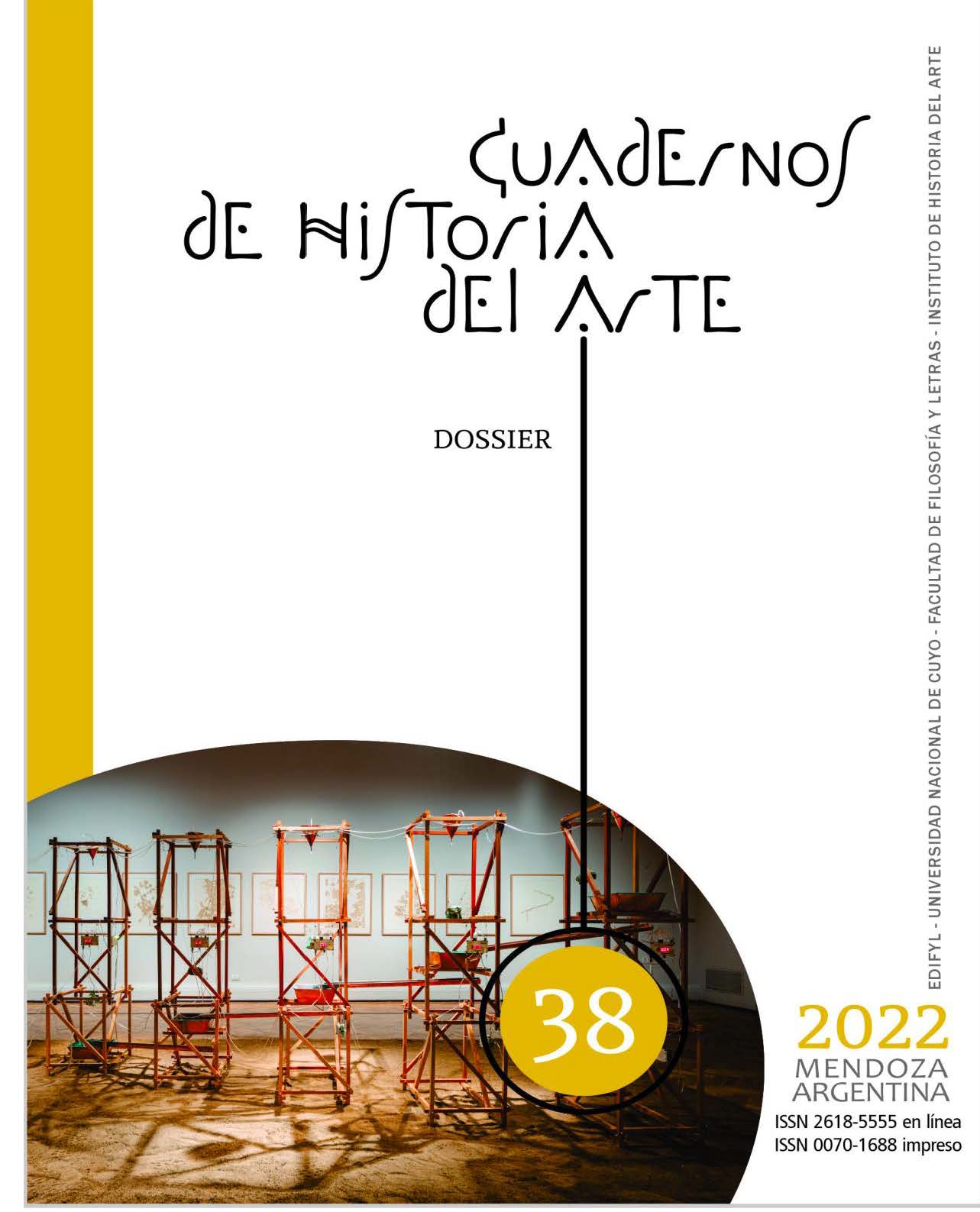Ciberfeminismo, arte y videojuegos
de VNS Matrix a Mónica Jacobo
Keywords:
CIBERFEMINISMO, ARTE, VNS MATRIX, JACOBOAbstract
This article aims to explore the intersection between art and videogames from cyberfeminism. Digital technologies and the Internet have become an object of examination by feminist artists. In the early ’90s, the Australian cyberfeminist collective VNS Matrix recreates from videogames from a critical view on patriarchal culture. Thirty years later, Mónica Jacobo, an artist from Córdoba, uses videogames to reflect demands and feminist struggles in Argentina. A critical-historical analysis of these two cyberfeminist expressions allows us to observe the transformations of cyberfeminism, from the so-called first cyberfeminism to the current one. But also to reflect, from a situated thought, on the features that cyberfeminism acquires in our latitudes.
References
AA.VV., First Cyberfeminist International. Kassel: Hybrid WorkSpace, 1998.
Barratt, Virginia, “On the origins of ‘All New Gen’, unrealized plans and the renewal of cyberfeminism”. Game Studies, n° 7 (2018).
Belli, Simone y Cristian López Raventós “Breve historia de los videojuegos”, Athenea Digital 14 (2008): 159-179. https://www.redalyc.org/pdf/537/53701409.pdf
Braidotti, Rosi, “Ciberfeminismo con una diferencia”, en: Zafra, R. y López-Pelliza, T. (eds.), Ciberfeminismo. De VNS matrix a laboria cuboniks (Barcelona: Holobionte, 2019), 189-211.
Burton, Julia. “De la Comisión al Socorro: trazos de militancia feminista por el derecho al aborto en Argentina”, Descentrada, n° 2, vol. 1 (2017): 1-17. https://www.descentrada.fahce.unlp.edu.ar/article/view/DESe020/8625.
Clark, Andy y Grethe Mitchell, Videogames and Art, (Bristol: Intellect Books, 2007).
D’Andrea, Aldana. “Ciberfeminismo”. En Glosario de Filosofía de la Técnica. Coordinado por Diego Parente, Agustín Berti y Claudio Celis, 87-91. Buenos Aires: La Cebra, 2022.
Evans, Claire. “An Oral History of the First Cyberfeminists”. Vice, 11 de diciembre de 2014. Acceso en enero de 2022. https://vnsmatrix.net/wordpress/wp-content/uploads/an-oral-history-of-the-first-cyberfeminists-claire-l-evans-motherboard-vice-dec-11-2014-online-article.pdf.
Flores, Val. “Lengua viva, disturbios somáticos, ¿deseo de normalización?”. En Antología degenerada. Una cartografía del lenguaje inclusivo, Editado por Sofía de Mauro, 19-39. Buenos Aires: Ediciones de la Biblioteca Nacional, 2021.
García Manso, Almudena. “Mujer, Género y Tecnología”. ¿Unas aliadas imperfectas?”, Sociedad, Consumo y sostenibilidad (Toledo: ACMS, 2008), 131-141.
García Sedano, Marcelino. “Arte y videojuegos. Reflexiones sobre lo lúdico, el arte y la tecnología en Asturias”. Liño. Revista Anual de Historia del Arte 23 (2017): 175-184. https://reunido.uniovi.es/index.php/RAHA/article/view/11922/10992.
García Oltra, Agnés. “La revolución de los píxeles. Arte y videojuegos en el mundo digital”, Revista Eviterna 7 (2020): 88-102. doi: 10.24310/Eviternare.v0i7.8382.
Galloway, Alex. “Un informe sobre ciberfeminismo. SadiePlant y VNS Matrix: análisis comparativo”. Mujeres en red, noviembre de 1997. Acceso enero de 2022. https://www.mujeresenred.net/spip.php?article1531.
Hester, Helen. “After the future: n hypoteses of Post-Cyberfeminism”. Beingres. Acceso enero 2022. https://beingres.org/2017/06/30/afterthefuture-helenhester/.
Jacobo, Mónica. “Videojuegos y arte. Primeras manifestaciones de Game Art en Argentina”. Cuadernos del Centro de Estudios en Diseño y Comunicación 41 (2012): 99-108. http://www.scielo.org.ar/scielo.php?script=sci_arttext&pid=S1853-35232012000300006.
Rackman, Melinda. “Manifiesto”. En Ciberfeminismo. De VNS Matrix a Laboria Cuboniks. Editado por Remdios Zafra y Teresa López-Pellisa, 45-49. Barcelona: Holobionte, 2019.
Seaman, Bill. “The emergence of new electronic forms in Australian art: Rodney Berry, John Colette, Linda Dement, Phillip George, Joyce Hinterding, Jon McCormack, Stelarc, VNS Matrix”. Continuum: Journal of Media & Cultural Studies, n° 1, vol. 8 (1994): 352-363.
Sollfrank, Cornelia, “La verdad sobre el ciberfeminismo”. En Ciberfeminismo. De VNS Matrix a Laboria Cuboniks. Editado por Remdios Zafra y Teresa López-Pellisa, 251-263. Barcelona: Holobionte Ediciones, 2019.
Strubin, Lucía y Lila Pagola. “Entrevista a Mónica Jacobo”. Ludión. Políticas y poéticas tecnológicas (2011). https://docplayer.es/21486424-Entrevista-a-monica-jacobo.html.
VNS Matrix, “Interviewed by Bernadette Flynn”. Continuum: Journal of Media & Cultural Studies, n° 1, vol. 8 (1994): 419-432.
Westecott, Emma, Hannah Epstein y Alexandra Leitc. “Feminist Art Game Praxis”, DIGRA, vol. 7 (2014). http://www.digra.org/digital-library/publications/feminist-art-game-praxis/.
Wilding, Faith. “Dónde está el feminismo en el ciberfeminismo?”, Lectora, n° 10, (Barcelona: Universitat de Barcelona, 2004): 141-151.
Zafra, Remedios. “Ciberfeminismo y ‘net-art’, redes interconectadas”. Mujeres en Red, abril de 2008. Acceso enero de 2022. https://www.mujeresenred.net/spip.php?article1454
Zafra, Remedios. “Redes Y (Ciber)feminismos. La revolución de la representación que derivó en alianza”. Revista Dígitos 4 (2018): 11-22. doi: 10.7203/rd.v0i4.116 https://revistadigitos.com/index.php/digitos.
Downloads
Published
How to Cite
Issue
Section
License
Copyright (c) 2022 Andrea Torrano

This work is licensed under a Creative Commons Attribution-NonCommercial-ShareAlike 3.0 Unported License.
Los artículos enviados al Comité Editor del Instituto de Historia del Arte, para ser publicados, los autores reservan su derecho de propiedad, pero otorgan a la Editorial los derechos de impresión y aceptan la difusión tanto en papel, como en internet y en aquellos sitios virtuales de las cuales los CHA formen parte.

Esta obra está bajo una Licencia Creative Commons Atribución-NoComercial-CompartirIgual 3.0 No portada



















_00.07_.55_2.png)




